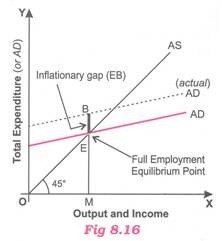Distinction between Inflationary and Deflationary Gap at the Equilibrium Level of Income!
Inflationary Gap:
Inflationary gap is the amount by which the actual aggregate demand exceeds ‘aggregate supply at level of full employment’.
For instance, in Fig. 8.16, BE is shown as inflationary gap. It is a measure of the excess of aggregate demand over level of output at full employment. Inflationary gap causes a rise in price level which is called inflation.
Deflationary Gap:
Deflationary gap is the amount by which actual aggregate demand falls short of aggregate supply at level of full employment’. For instance, in Fig. 8.17, EB is shown as deflationary gap. It is a measure of amount of deficiency of aggregate demand. Deflationary gap causes a decline in output, income and employment along with persistent fall in prices.
Deflationary gap and equilibrium level of income:
Remember, equilibrium level of income indicates mere equality between aggregate demand and aggregate supply regardless of whether the equilibrium is at full employment or under-employment of resources.
In case, it is full employment equilibrium where all resources are employed to their full limit, deflationary gap cannot exist at equilibrium level of income. But if it is an under-employment equilibrium where all resources are not fully employed, i.e., some resources are underemployed, then deflationary gap can exist at the equilibrium level of income.
ADVERTISEMENTS:
Conclusion:
We may conclude our discussion in this way Equilibrium level of national income is determined by the equality between aggregate demand and aggregate supply (or between savings and investment). An ideal situation for an economy is full employment equilibrium, i.e., when its aggregate demand and aggregate supply are in equilibrium at such a point where all the resources of the economy are fully employed. Every economy aspires for it.
But in real world situation, aggregate demand either exceeds or falls short of the level of full employment supply. Excess demand results in inflation without an increase in output and employment whereas deficient demand leads to unemployment and fall in output, income and prices.
Both the situations bring harmful effects on the economy and, therefore, require to be checked by adopting fiscal, monetary and other measures. All these measures should be integrated and used as complementary to each other, rather counter to each other. Therefore, all efforts should be made to achieve and stay at the equilibrium level of income ensuring full employment of all the available resources.

